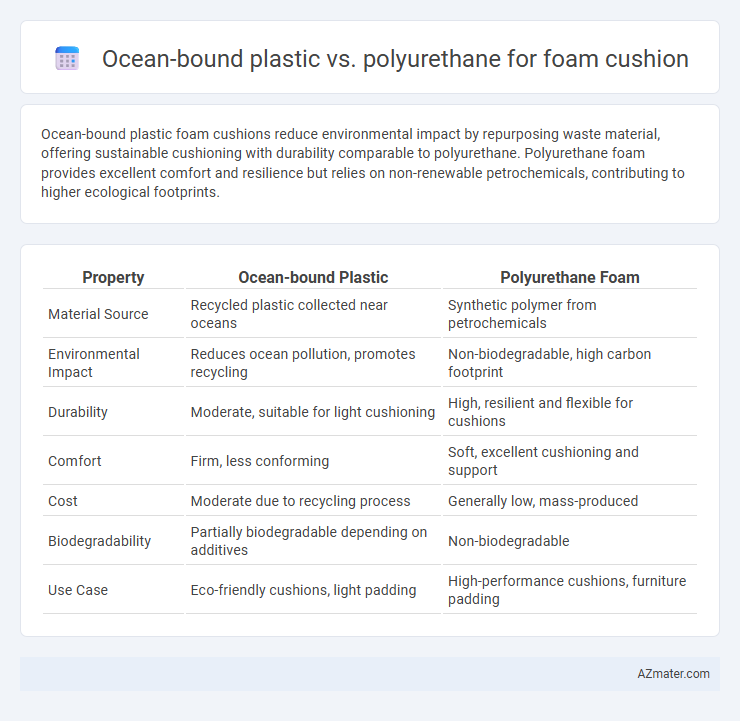Ocean-bound plastic foam cushions reduce environmental impact by repurposing waste material, offering sustainable cushioning with durability comparable to polyurethane. Polyurethane foam provides excellent comfort and resilience but relies on non-renewable petrochemicals, contributing to higher ecological footprints.
Table of Comparison
| Property | Ocean-bound Plastic | Polyurethane Foam |
|---|---|---|
| Material Source | Recycled plastic collected near oceans | Synthetic polymer from petrochemicals |
| Environmental Impact | Reduces ocean pollution, promotes recycling | Non-biodegradable, high carbon footprint |
| Durability | Moderate, suitable for light cushioning | High, resilient and flexible for cushions |
| Comfort | Firm, less conforming | Soft, excellent cushioning and support |
| Cost | Moderate due to recycling process | Generally low, mass-produced |
| Biodegradability | Partially biodegradable depending on additives | Non-biodegradable |
| Use Case | Eco-friendly cushions, light padding | High-performance cushions, furniture padding |
Understanding Ocean-Bound Plastic: Definition and Sources
Ocean-bound plastic refers to plastic debris found within 50 kilometers of coastlines, destined to enter marine environments, originating from sources such as coastal cities, rivers, and improperly managed waste systems. Unlike polyurethane foam, a synthetic polymer widely used in cushioning for its durability and comfort, ocean-bound plastics are primarily single-use items like bottles and packaging materials, posing significant ecological threats. Utilizing recycled ocean-bound plastic in foam cushions promotes sustainable manufacturing by reducing plastic pollution and conserving resources compared to traditional polyurethane production.
What is Polyurethane Foam? Composition and Uses
Polyurethane foam is a versatile polymer composed of organic units joined by carbamate links, commonly derived from polyols and isocyanates. Its unique cellular structure provides excellent cushioning, making it widely used in furniture, mattresses, automotive seating, and packaging. Unlike ocean-bound plastic, which is recycled from waste collected near coastlines to reduce pollution, polyurethane foam is a synthetic material specifically engineered for comfort and durability in foam cushions.
Environmental Impact: Ocean-Bound Plastic vs Polyurethane
Ocean-bound plastic foam cushions significantly reduce marine pollution by repurposing plastics destined for oceans, decreasing landfill waste and minimizing toxic leachates. Polyurethane foam production emits volatile organic compounds and relies heavily on non-renewable petroleum, contributing to carbon emissions and long-term environmental degradation. Utilizing ocean-bound plastic supports circular economy principles, offering a sustainable alternative with lower ecological footprint compared to traditional polyurethane cushions.
Production Processes: Sustainability and Resource Consumption
Ocean-bound plastic foam cushions are produced by recycling plastic waste collected near coastlines, reducing pollution and conserving marine ecosystems through lower energy use and material repurposing. Polyurethane foam cushions require petrochemical extraction and energy-intensive synthesis, contributing to higher carbon emissions and reliance on non-renewable fossil fuels. The sustainable production of ocean-bound plastic cushions demonstrates significant advantages in resource efficiency and environmental impact over conventional polyurethane manufacturing.
Foam Cushion Performance: Comparing Comfort and Durability
Ocean-bound plastic foam cushions offer sustainable comfort by integrating recycled materials without compromising softness and support, providing excellent cushioning that adapts to body contours. Polyurethane foam cushions excel in durability and resilience, maintaining consistent shape and firmness over extended use while providing superior shock absorption. Both materials ensure effective pressure distribution, but polyurethane typically outperforms ocean-bound plastic foam in long-term wear resistance and structural integrity.
Recyclability and End-of-Life Considerations
Ocean-bound plastic foam cushions offer enhanced recyclability due to their origin from post-consumer waste, allowing them to be reprocessed into new products and reducing landfill contribution. Polyurethane foam cushions, while durable and comfortable, face challenges in end-of-life management because they are less commonly recycled and often end up incinerated or landfilled, contributing to environmental pollution. Choosing ocean-bound plastic foam cushions supports circular economy goals by closing the material loop and minimizing ecological impact through improved waste recovery systems.
Cost Analysis: Ocean-Bound Plastic vs Polyurethane Foam
Ocean-bound plastic foam cushions typically incur higher initial manufacturing costs due to complex recycling and processing requirements compared to mass-produced polyurethane foam. Polyurethane foam benefits from established supply chains and economies of scale, resulting in lower unit costs and greater price competitiveness. However, ocean-bound plastic cushions may offer long-term value through enhanced environmental branding and potential regulatory incentives promoting sustainable materials.
Market Trends: Consumer Demand and Industry Adoption
Ocean-bound plastic foam cushions are gaining traction as consumers increasingly favor sustainable and eco-friendly products, driving market demand for alternatives to traditional polyurethane foam. Industry adoption is accelerating, with manufacturers integrating recycled ocean-bound plastics to reduce environmental impact and meet regulatory pressures. Market trends indicate a growing preference for circular economy solutions, positioning ocean-bound plastic as a competitive and innovative material in the foam cushion segment.
Health and Safety: Chemical Exposure and Allergen Risks
Ocean-bound plastic foam cushions reduce chemical exposure by utilizing recycled materials free from harmful additives commonly found in polyurethane foams, which often contain isocyanates linked to respiratory issues. Polyurethane cushions may release volatile organic compounds (VOCs) and pose allergen risks for sensitive individuals due to residual catalysts and stabilizers used in production. Selecting ocean-bound plastic foam cushions enhances health and safety by minimizing toxic emissions and allergen potential while supporting environmental sustainability.
Future Innovations in Sustainable Foam Cushion Materials
Future innovations in sustainable foam cushion materials increasingly prioritize ocean-bound plastic as a renewable feedstock, reducing environmental impact by preventing marine pollution. Research focuses on integrating recycled ocean-bound plastics with advanced polyurethane formulations to create durable, eco-friendly foam cushions with enhanced softness and resilience. Emerging technologies aim to optimize biodegradability and carbon footprint reduction, promoting circular economy principles in furniture and automotive upholstery industries.

Infographic: Ocean-bound plastic vs Polyurethane for Foam cushion
 azmater.com
azmater.com